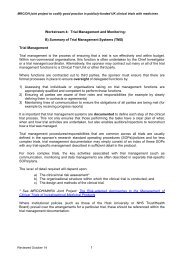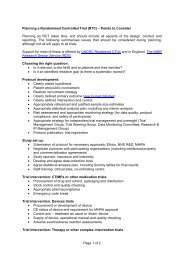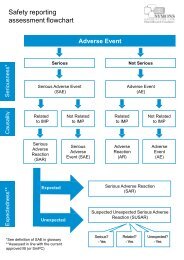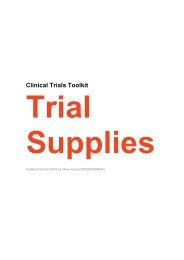Monitoring Procedures Workstream Document (PDF, 379.02 KB)
Monitoring Procedures Workstream Document (PDF, 379.02 KB)
Monitoring Procedures Workstream Document (PDF, 379.02 KB)
You also want an ePaper? Increase the reach of your titles
YUMPU automatically turns print PDFs into web optimized ePapers that Google loves.
MRC/DH joint project to codify good practice in publicly-funded UK clinical trials with medicines<br />
practice, a more intensive monitoring approach may need to be applied.<br />
In pharmaceutical company sponsored trials, a high percentage of source data verification<br />
occurs but historically, this approach has not been utilised widely by non-commercial sponsors<br />
(on site monitoring with a high percentage of source data verification is very resource intensive)<br />
and may not be useful depending on the trial 9 . Use of central laboratories and blinded<br />
endpoint adjudication processes provide other opportunities for Quality Assurance.<br />
4.5 Investigational Medicinal Product (IMP) Storage, Dispensing and Accountability<br />
It is important to ensure that appropriate storage, dispensing, accountability and destruction<br />
arrangements are in place. If IMPs are not being stored in a pharmacy, the storage conditions<br />
may need to be checked.<br />
In trials where pharmacies are dispensing IMPs, the trial team may need to verify that the<br />
correct supplies are being used and staff understand the requirements of the trial. This is<br />
particularly important when site staff are involved in randomisation or unblinding procedures (or<br />
if, for example, IMP is unblinded to pharmacy staff).<br />
The intensity of monitoring of IMP will again be determined by a risk based approach with a<br />
higher intensity employed where IMP storage or compliance are critical to the end points of the<br />
trial. For example, a vaccine may need to be stored within a narrow range of temperature or<br />
may lose its potency so specific checks to confirm that it has been transported/stored<br />
appropriately may be warranted.<br />
If IMPs are coming from routine stocks it may be advisable to confirm that what is being<br />
dispensed is the product specified in the protocol. Where central monitoring is employed, the<br />
case report form (CRF) may be designed to capture and positively confirm information relating to<br />
compliance, or that dosing or dispensing of IMP is in accordance with the protocol.<br />
5. Responsibilities and Training of <strong>Monitoring</strong> Staff<br />
Trial monitoring procedures should be described in such a way as to make clear the<br />
responsibilities of all staff involved. A site monitoring standard operating procedure (SOP) is<br />
recommended to specify any generic monitoring procedures.<br />
To monitor a trial successfully requires both relevant scientific and/or clinical knowledge and<br />
a good working knowledge of Good Clinical Practice and the Clinical Trials Regulations.<br />
Appropriate training on all aspects of the trial protocol and the procedures/processes to be<br />
followed, is also required.<br />
It is recommended that qualifications and training be documented (e.g. in the CV and/or training<br />
records held by the individual or Personnel department). In many cases, developing a<br />
mentoring system with more senior staff supporting junior colleagues is recommended. Such<br />
an approach not only provides an appropriate environment for Continuing Professional<br />
Development but also enables a consistent approach to monitoring within a team. It is<br />
recommended that on-the-job training of this sort is documented in staff training records.<br />
6. <strong>Monitoring</strong> Reports<br />
<strong>Monitoring</strong> visits and other monitoring procedures should be recorded. Visit reports would<br />
typically include the date, site, name of the monitor, and name of the investigator(s) or other<br />
individuals contacted, as well as a summary of what was reviewed.<br />
The monitor should record significant findings, any deficiencies detected and any recommended<br />
actions. Information relating to the resolution/outcome of any historical findings should be<br />
included.<br />
7. <strong>Procedures</strong> for Dealing with the Issues Raised by <strong>Monitoring</strong><br />
The review/sign-off process for monitoring reports should be defined and documented.<br />
The procedure for dealing with issues arising from monitoring visits and monitoring checks<br />
should be provided. As unanticipated risks may emerge in the course of a trial; it is<br />
recommended that the monitoring plan is kept under review and modified as necessary. It is<br />
9 Bakobaki J et al. The potential for central monitoring techniques to replace on-site monitoring: findings<br />
from an international multi-centre clinical trial. Clinical Trials 2012; 9: 257-264.<br />
Updated November 2012 8







